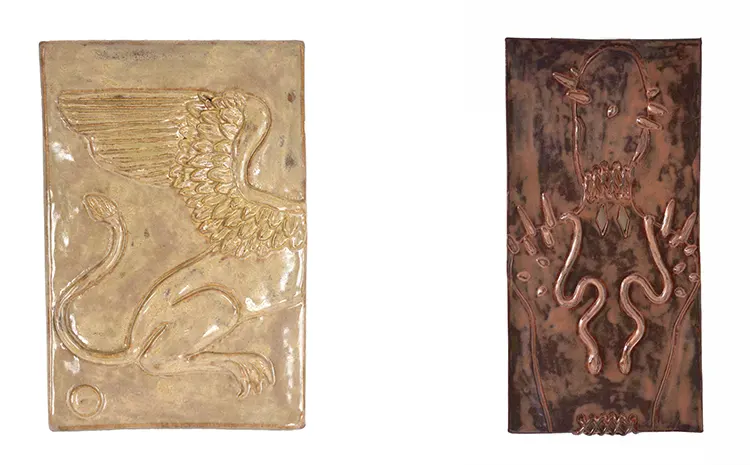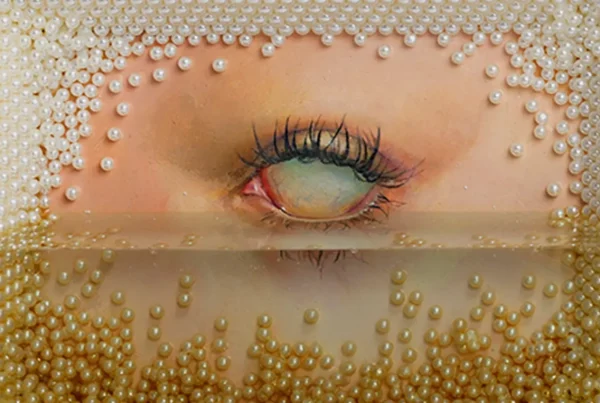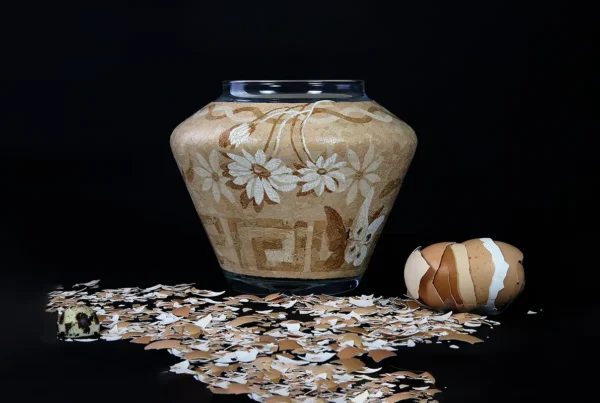“I create sculptures that could be described as anachronistic artefacts; they could be from the future or an ancient past, playing with the line between sentient character and inanimate object.”
Becky Tucker: Roots and Beginnings
Born in the quaint locale of Robin Hoods Bay in North Yorkshire and now flourishing in Glasgow, Becky Tucker‘s journey to artistic acclaim is a tale of self-discovery and passion. Her early years, spent in an environment far removed from the bustling art scenes of major cities, did not initially hint at a future in art. In fact, Becky’s journey into the art world was not born from a singular moment of inspiration but rather evolved from a lifelong affinity for creation and imagination. As a child, she found solace and expression in filling sketchbooks with drawings, a humble yet profound beginning that laid the groundwork for her future.
The path to becoming an established artist was not straightforward for Becky. Her time at university, studying Fine Art, was marked by a period of exploration and uncertainty. Her initial creations, which she candidly describes as “very bad and boring,” were a far cry from the evocative works she is known for today. It was during this time of introspection and pause from her studies that Becky truly began to understand what she wanted from her art. This self-realization led her to collaborate with friends for a small show in London in early 2022, marking the turning point in her career. This event was the catalyst that propelled her into the art world, resonating with an audience and opening doors to more established galleries and opportunities.
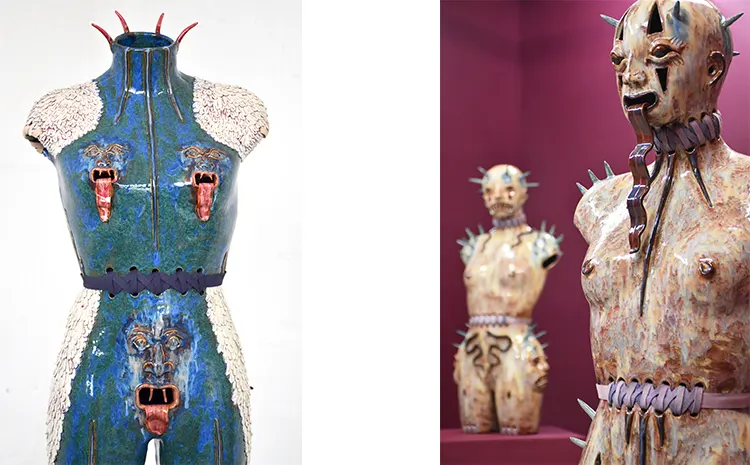
The Artistic Essence of Becky Tucker
Becky Tucker’s artistic style is a mesmerizing blend of historical and futuristic elements, creating sculptures that defy time. Her works, often described as anachronistic artefacts, draw inspiration from a myriad of sources. These include film, architecture, costume, and ancient artefacts, each contributing to the unique aesthetic of her creations. The sculptures she crafts blur the lines between the animate and inanimate, playing with themes of opposition, doubling, and mimicry. They often reference the animal or human body, adding a layer of familiarity to the otherwise surreal and timeless pieces.
Central to Becky’s artistic vision is the mutable nature of symbols, a concept that forms the foundation of her research. She frequently incorporates motifs like the lion, griffin, or snake into her works. These symbols, laden with historical and cultural significance, allow her sculptures to transcend linear interpretations. Becky’s artistry lies in her ability to create objects that are at once erotic without being explicit, grotesque yet bordering on beautiful, ancient while simultaneously futuristic. Her works are a testament to the power of art to transcend time and culture, inviting viewers into a world where the past and future converge in intriguing harmony.

Becky Tucker: The Enigma of ‘The Laughing Fool’
Among the myriad of works that have inspired Becky Tucker, ‘The Laughing Fool,’ a painting attributed to Jacob Cornelisz Van Oostsanen, holds a place of special significance. This artwork, dating back to around 1500, captivates her with its blend of humor and sinister undertones. The painting, featuring a court jester in a contradictory expression of smiling and grimacing, resonates deeply with Becky. Its uncertain provenance and the artist’s enigmatic history add to its allure. ‘The Laughing Fool’ strikes a chord with her, not just for its artistic merit but for the air of mystery that surrounds it. In an age where digital access often strips away the enigma of art, this painting stands as a beacon of mystery and intrigue for her.
This painting played a pivotal role in her solo show ‘Arca,’ influencing her research and artistic direction. The paradoxical nature of the painting, hovering between contradictory moods and themes, aligns perfectly with Becky’s own artistic ethos. Her fascination with works that possess a dual nature, simultaneously ancient and futuristic, grotesque and beautiful, is mirrored in her reverence for ‘The Laughing Fool.’ This piece, elusive in its physical form and rich in symbolic complexity, embodies the very essence of what drives Becky Tucker’s artistic explorations.
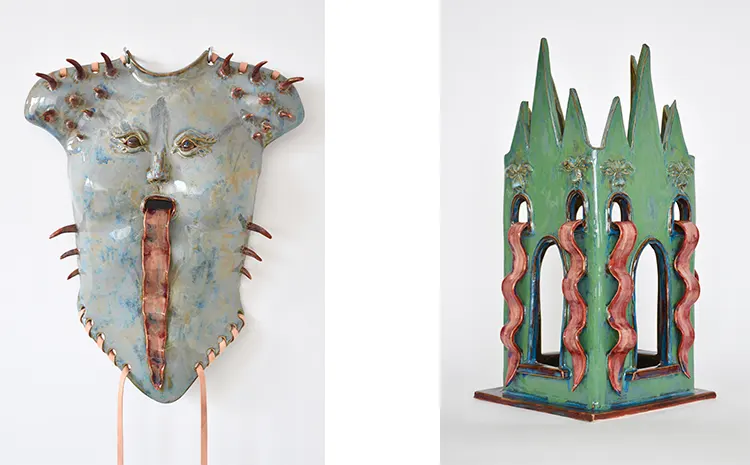
Becky Tucker: A Sculptor’s Sanctuary
Becky Tucker’s studio, nestled in an industrial estate outside Glasgow, is more than just a workspace; it is a crucible of creativity and discipline. This sanctuary, where her artistic visions come to life, is a reflection of her commitment to her craft. The recent acquisition of her own kiln marked a significant milestone in Becky’s career, profoundly changing her approach to ceramics. This addition allows her the freedom to pursue more ambitious projects, unencumbered by the limitations she once faced. In her studio, the essentials are simple yet profound: water, clay, her hands, and a table. Alongside a few sculpting tools and a rolling pin for hand-rolled slabs, these basic elements are the cornerstones of her creative process.
Becky’s approach to maintaining focus and productivity in her studio is as disciplined as it is unique. She sets alarms to break her work into intervals, ensuring time for rest and reflection. This routine helps her maintain a balance between intense focus and necessary breaks, allowing her to approach her work with renewed vigor and perspective. Furthermore, her studio is not just a place of work but a repository of inspiration. A growing collection of books on topics ranging from archaeology to heraldry serves as both a resource and a refuge. When not deeply engrossed in her sculpting, Becky finds solace in the natural beauty surrounding her studio. A run along the nearby river path provides a physical and mental reset, enabling her to return to her work with clarity and purpose.
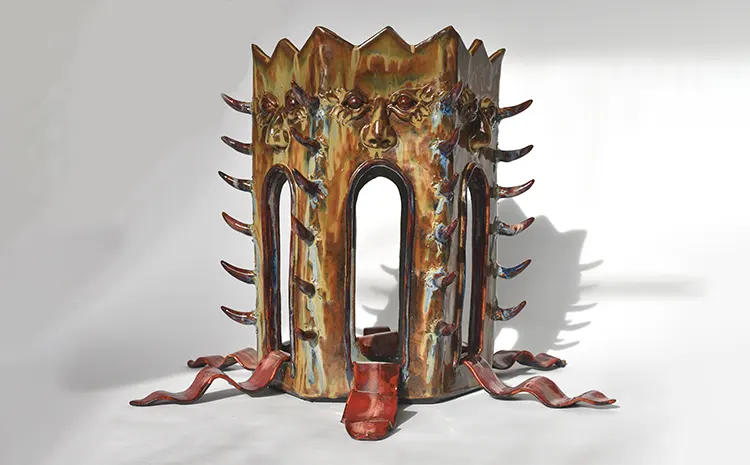
Influences and Inspirations
Becky Tucker’s artistic influences are as eclectic as her creations. While she often turns to historical sources for inspiration, contemporary artists like Rajni Perera and David Altmejd also hold a special place in her artistic heart. Perera’s sculptural works, particularly her show at Tramway in Glasgow, left a lasting impression on Becky, showcasing the boundless possibilities of sculpture. Similarly, Altmejd’s work, which stands in stark contrast to the ‘classical’ sculptures Becky encountered in her youth, opened her mind to the vast potential of the medium.
Beyond the world of contemporary art, Becky finds inspiration in the realms of arms and armour, medieval art, and even pop culture. Her frequent visits to Leeds Armoury during her childhood imbued her with a fascination for ornate metal shells, a fascination that is palpably reflected in her work. The influence of motorbikes and the ritual of donning leather armour, along with her childhood obsession with Power Rangers, underscores the impact of costume and armour on her artistic style. Additionally, the rich tapestry of medieval art, with its bestiaries and marginal drolleries, feeds into the anachronistic nature of her work. Becky’s diverse range of influences, from fashion and film to literature, ensures that her work remains fresh, dynamic, and continuously evolving.
